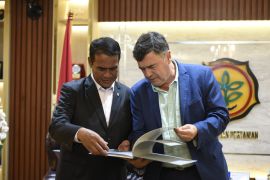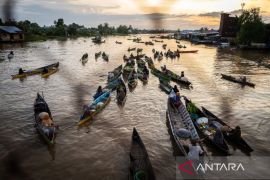The Juwana River provides all those agricultural areas with an adequate supply of irrigation water.
Pati is also blessed with abundant natural resources that can be found on land and sea — something other regions have reason to be envious of.
However, the district still battles issues related to drought every year when the dry season comes around. The current drought has led to a scarcity of clean water in several regions in the district.
People living in all 11 villages of Jaken Sub-district, for instance, are no strangers to difficulties in obtaining clean water.
This year, they have been forced to rely on the supply of clean water provided by the government.
These villages lie at the foothills of Kendeng Mountains, which have long served as a water reservoir area, providing local residents with a considerable supply of water.
However, with an increase in population, the function of the foothills has shifted from simply storing water to serving as the base for several activities, including mining, which is suspected to be responsible for shrinking water sources.
It has taken some time for local residents to notice the adverse impacts resulting from the constant change in land use patterns on Kendeng Mountains. During long dry seasons, like now, villagers have begun facing difficulties in accessing clean water since they can no longer turn to the water sources they used to rely on earlier.
In addition to residents of Jaken sub-district, people in other regions located in the area, such as Tambakromo, Sukolilo, Gabus, and Pucakwangi Sub-districts, have also started experiencing similar difficulties. As a result, they are also relying on clean water supply provided by the Pati government or communities volunteering to distribute water.
To help the people, the Regional Disaster Mitigation Agency (BPBD) of Pati has continued to distribute clean water to those living in drought-affected villages.
As per reported data, the number of villages hit by drought has shot up from about 40 in early September 2023 to 70. Those villages are scattered across 9 of Pati’s 21 sub-districts.
If the El Nino-induced dry season were to last longer, an even larger population in the district would be affected by it, thereby endangering even the stock of water stored by the Pati BPBD.
Long-term solutions
Collective measures are required in order to deal with the impact of the prolonged dry season. For instance, it is necessary for all parties to work together to carry out reforestation efforts in mountainous areas, especially Kendeng Mountains, considering the declining number of water sources available in the region.
Next, all parties, including the people, need to cooperate and come up with plans for ensuring water availability during dry seasons, including by implementing the community-based water supply and sanitation (Pamsimas) program and creating retention ponds in drought-prone regions.
“We would like to invite people to demonstrate their care about the environment by planting and protecting trees in an effort to prevent drought during dry seasons,” the head of Pati BPBD, Martinus Budi Prasetyo, said.
The Pati district government has initiated a campaign to restore green spaces in mountainous areas by executing and promoting planting activities.
As part of the campaign, the district government planted as many as 5 thousand seeds, including fruit trees and grasses, in several spots in Tambakromo sub-district in late 2022.
According to Henggar Budi Anggoro, the acting head of Pati district, the seeds were planted with the goal of restoring the function of the spots as water reservoirs.
To complement the initiative, the Pati district government is unwaveringly educating communities to raise their awareness on the importance of retransforming barren forests into lush areas that are capable of reserving rainwater and protecting the people from potential flash floods during rainy seasons.
It is believed that efforts to grow more plants would result in improved capability of forests in reserving water. By reserving higher amounts of water, people could worry less about the threat of water scarcity during dry seasons.
Meanwhile, letting the decline in green areas in the upstream of rivers to continue would cost the downstream regions in terms of raising the threat of drought.
Developing water management
Apart from restoring green areas, the Pati district government is also striving to overcome drought-related issues by initiating a program to guide people to improve water management.
Husaini, a disaster risk reduction and environment activist, has urged the district government to begin educating people on how to manage water reserves properly.
He averred that in addition to increasingly massive deforestation and land conversion, the clean water crisis in Pati has been caused by a lack of knowledge on the proper management of water.
In view of this, it is necessary to conduct research that can help map current water demand and availability. Furthermore, significant efforts are needed to provide people with media for storing water, which they can use during dry seasons.
Hence, it is essential for the government to build people’s awareness on the importance of improving water management while highlighting the fact that climate change and damage to the environment have affected the planet in a negative way.
All parties also need to collaborate to manage disasters and crises by adapting to changes.
In order to guide people to properly manage water, the government must promote and implement forest restoration and conservation programs at the earliest.
All those measures are crucial to help people build their awareness and capability to manage water, so that they no longer need to solely rely on water supply from the government during drought.
Related news: South Kalimantan distributes clean water to drought-affected regions
Related news: Need to optimize water resources to mitigate drought: BMKG
Editor: Rahmad Nasution
Copyright © ANTARA 2023












